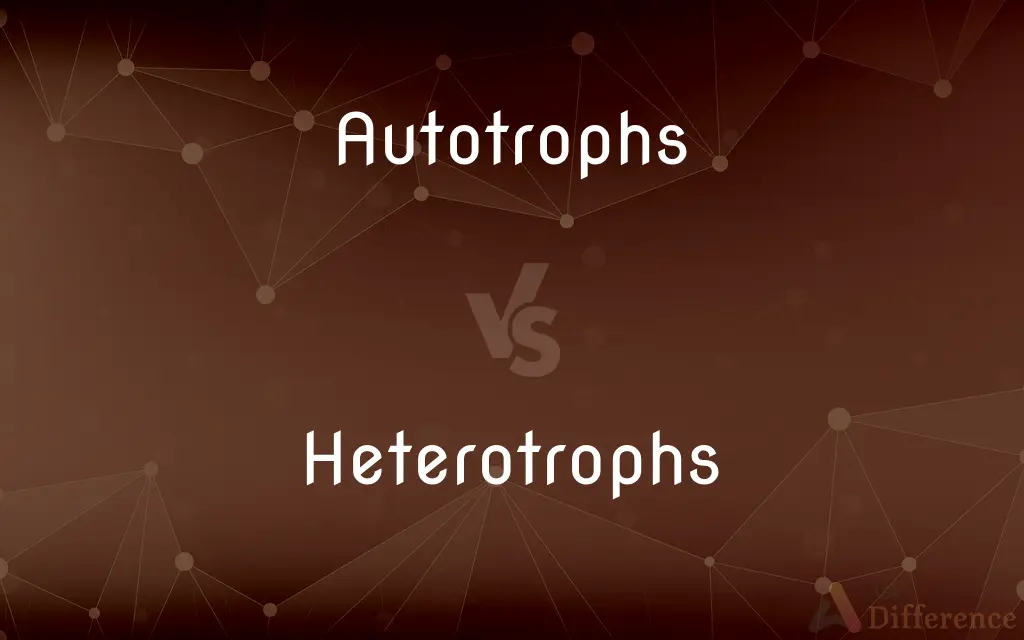Autotrophs vs. Heterotrophs — What's the Difference?
Edited by Tayyaba Rehman — By Fiza Rafique — Published on December 25, 2023
Autotrophs produce their own food through photosynthesis or chemosynthesis, while heterotrophs obtain food by consuming other organisms.

Difference Between Autotrophs and Heterotrophs
Table of Contents
ADVERTISEMENT
Key Differences
Autotrophs are organisms that have the unique ability to produce their own food using light or chemical energy. This process can occur through photosynthesis, where energy from the sun is harnessed, or through chemosynthesis, where chemical energy is utilized. Heterotrophs, in contrast, are organisms that cannot produce their own food. Instead, they rely on consuming other living things, either plants, animals, or both, to obtain the necessary nutrients for survival.
At the foundational level of many ecosystems, autotrophs serve as primary producers. By converting inorganic substances into organic compounds, autotrophs provide energy and matter that sustains many other forms of life. Heterotrophs, on the other hand, function as consumers in the ecosystem. They obtain organic compounds by feeding on autotrophs or other heterotrophs, facilitating the transfer of energy through the food chain or web.
One of the significant differences between autotrophs and heterotrophs lies in their energy sources. Autotrophs harness energy directly from physical sources, such as sunlight or inorganic chemical reactions. Heterotrophs, conversely, derive their energy from the organic compounds present in the organisms they consume.
In essence, the relationship between autotrophs and heterotrophs is symbiotic and essential for the balance and functioning of an ecosystem. Autotrophs generate the foundational organic matter and energy, while heterotrophs, through consumption, ensure the recycling of organic substances and the flow of energy through various trophic levels.
Comparison Chart
Energy Source
Sunlight or chemicals
Organic compounds from other organisms
ADVERTISEMENT
Role in Ecosystem
Primary producers
Consumers
Food Production
Produce their own food
Rely on consumption of other organisms
Examples
Plants, algae, certain bacteria
Animals, fungi, many bacteria
Dependence on Others
Typically independent in energy acquisition
Dependent on other organisms for food
Compare with Definitions
Autotrophs
Self-nourishing entities using sunlight or chemical energy.
Certain bacteria are autotrophs that derive energy from inorganic chemical reactions.
Heterotrophs
Entities that cannot produce their organic compounds.
All animals, being heterotrophs, rely on consuming other organisms.
Autotrophs
Primary producers in an ecosystem.
Algae, being autotrophs, form the base of aquatic food chains.
Heterotrophs
Organisms dependent on others for their food.
Humans are heterotrophs because they consume plants and animals for sustenance.
Autotrophs
Organisms that produce their own food from inorganic substances.
Green plants are autotrophs because they make food through photosynthesis.
Heterotrophs
Consumers in the food chain.
Birds, as heterotrophs, might feed on insects and fruits.
Autotrophs
Life forms converting non-living materials into organic compounds.
Autotrophs play a pivotal role by converting sunlight into energy for other organisms.
Heterotrophs
Life forms that cannot synthesize their own food from inorganic sources.
Being heterotrophs, cats need to hunt or be provided with food.
Autotrophs
Entities synthesizing their organic molecules from simple inorganic ones.
Autotrophs ensure that energy flows into the ecosystem.
Heterotrophs
Organisms deriving their nutritional requirements from complex organic substances.
Fungi are heterotrophs that break down dead organic matter.
Autotrophs
An organism capable of synthesizing its own food from inorganic substances, using light or chemical energy. Green plants, algae, and certain bacteria are autotrophs.
Heterotrophs
An organism that is dependent on complex organic substances for nutrition because it cannot synthesize its own food.
Autotrophs
Plural of autotroph
Heterotrophs
Plural of heterotroph
Common Curiosities
Are all plants autotrophs?
Most plants are autotrophs, as they produce food through photosynthesis, but some parasitic plants are exceptions.
How do autotrophs contribute to the food chain?
Autotrophs serve as the primary producers, forming the base of the food chain.
What energy source do autotrophs primarily use?
Autotrophs primarily use sunlight or inorganic chemical reactions as energy sources.
Do autotrophs rely on other organisms for nutrition?
No, autotrophs produce their own food from inorganic sources.
How do heterotrophs obtain their food?
Heterotrophs obtain their food by consuming other organisms.
Are there bacteria that are autotrophs?
Yes, certain bacteria are autotrophs, producing food through chemosynthesis.
Can autotrophs survive without sunlight?
Some autotrophs, like those that rely on chemosynthesis, can survive without sunlight.
What would happen if there were no heterotrophs?
Without heterotrophs, there would be limited movement of energy through higher trophic levels, possibly causing an overabundance of primary producers.
Can heterotrophs produce their own food?
No, heterotrophs cannot produce their own food and rely on consumption of other organisms.
Are humans autotrophs or heterotrophs?
Humans are heterotrophs because they consume other organisms for food.
Are all animals heterotrophs?
Yes, all animals are heterotrophs and rely on consuming other organisms.
How do autotrophs benefit heterotrophs in an ecosystem?
Autotrophs produce organic matter and energy, which heterotrophs rely on for sustenance.
Why are heterotrophs dependent on autotrophs?
Heterotrophs are dependent on autotrophs because they consume the organic matter and energy that autotrophs produce.
What are some examples of heterotrophs?
Animals, fungi, and many bacteria are examples of heterotrophs.
Do heterotrophs contribute to the decomposition process?
Yes, many heterotrophs, especially fungi and certain bacteria, play a crucial role in decomposition.
Share Your Discovery

Previous Comparison
Kathak Dance vs. Kathakali Dance
Next Comparison
Template Strand vs. Coding StrandAuthor Spotlight
Written by
Fiza RafiqueFiza Rafique is a skilled content writer at AskDifference.com, where she meticulously refines and enhances written pieces. Drawing from her vast editorial expertise, Fiza ensures clarity, accuracy, and precision in every article. Passionate about language, she continually seeks to elevate the quality of content for readers worldwide.
Edited by
Tayyaba RehmanTayyaba Rehman is a distinguished writer, currently serving as a primary contributor to askdifference.com. As a researcher in semantics and etymology, Tayyaba's passion for the complexity of languages and their distinctions has found a perfect home on the platform. Tayyaba delves into the intricacies of language, distinguishing between commonly confused words and phrases, thereby providing clarity for readers worldwide.














































